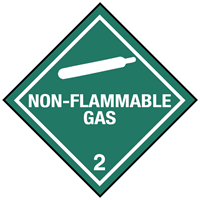
 Print
Print
Chemical Datasheet
XENON |

|
Chemical Identifiers
| CAS Number |
UN/NA Number |
DOT Hazard Label |
USCG CHRIS Code |
|
|
|
|
none
|
| NIOSH Pocket Guide |
International Chem Safety Card |
|
none
|
|
NFPA 704
data unavailable
General Description
A colorless odorless gas. Noncombustible. Heavier than air. May asphyxiate by the displacement of air. Under prolonged exposure to fire or heat containers may rupture violently and rocket.
Hazards
Reactivity Alerts
none
Air & Water Reactions
No rapid reaction with air. No rapid reaction with water.
Fire Hazard
Excerpt from ERG Guide 120 [Gases - Inert (Including Refrigerated Liquids)]:
Non-flammable gases. Containers may explode when heated. Ruptured cylinders may rocket. (ERG, 2024)
Health Hazard
Excerpt from ERG Guide 120 [Gases - Inert (Including Refrigerated Liquids)]:
Vapors may cause dizziness or asphyxiation without warning, especially when in closed or confined areas. Vapors from liquefied gas are initially heavier than air and spread along ground. Contact with gas, liquefied gas or cryogenic liquids may cause burns, severe injury and/or frostbite. (ERG, 2024)
Reactivity Profile
These substances undergo chemical reactions only under relatively severe circumstances or in the presence of an effective catalyst that promotes reaction. They are resistant to ignition, although they may become flammable at very high temperatures. They will be resistant to oxidation/reduction, except in the most severe conditions. These materials may be nontoxic. They can asphyxiate.
Belongs to the Following Reactive Group(s)
Potentially Incompatible Absorbents
No information available.
Response Recommendations
Isolation and Evacuation
Excerpt from ERG Guide 120 [Gases - Inert (Including Refrigerated Liquids)]:
IMMEDIATE PRECAUTIONARY MEASURE: Isolate spill or leak area for at least 100 meters (330 feet) in all directions.
LARGE SPILL: Consider initial downwind evacuation for at least 100 meters (330 feet).
FIRE: If tank, rail tank car or highway tank is involved in a fire, ISOLATE for 800 meters (1/2 mile) in all directions; also, consider initial evacuation for 800 meters (1/2 mile) in all directions. (ERG, 2024)
Firefighting
Excerpt from ERG Guide 120 [Gases - Inert (Including Refrigerated Liquids)]:
Use extinguishing agent suitable for type of surrounding fire. If it can be done safely, move undamaged containers away from the area around the fire. Damaged cylinders should be handled only by specialists.
FIRE INVOLVING TANKS: Fight fire from maximum distance or use unmanned master stream devices or monitor nozzles. Cool containers with flooding quantities of water until well after fire is out. Do not direct water at source of leak or safety devices; icing may occur. Withdraw immediately in case of rising sound from venting safety devices or discoloration of tank. ALWAYS stay away from tanks in direct contact with flames. (ERG, 2024)
Non-Fire Response
Excerpt from ERG Guide 120 [Gases - Inert (Including Refrigerated Liquids)]:
Do not touch or walk through spilled material. Stop leak if you can do it without risk. Use water spray to reduce vapors or divert vapor cloud drift. Avoid allowing water runoff to contact spilled material. Do not direct water at spill or source of leak. If possible, turn leaking containers so that gas escapes rather than liquid. Prevent entry into waterways, sewers, basements or confined areas. Allow substance to evaporate. Ventilate the area. CAUTION: When in contact with refrigerated/cryogenic liquids, many materials become brittle and are likely to break without warning. (ERG, 2024)
Protective Clothing
Excerpt from ERG Guide 120 [Gases - Inert (Including Refrigerated Liquids)]:
Wear positive pressure self-contained breathing apparatus (SCBA). Structural firefighters' protective clothing provides thermal protection but only limited chemical protection. Always wear thermal protective clothing when handling refrigerated/cryogenic liquids or solids. (ERG, 2024)
DuPont Tychem® Suit Fabrics
No information available.
First Aid
Excerpt from ERG Guide 120 [Gases - Inert (Including Refrigerated Liquids)]:
Refer to the "General First Aid" section. Specific First Aid: Clothing frozen to the skin should be thawed before being removed. In case of contact with liquefied gas, only medical personnel should attempt thawing frosted parts. (ERG, 2024)
Physical Properties
Flash Point: data unavailable
Lower Explosive Limit (LEL): data unavailable
Upper Explosive Limit (UEL): data unavailable
Autoignition Temperature: data unavailable
Melting Point: data unavailable
Vapor Pressure: data unavailable
Vapor Density (Relative to Air): data unavailable
Specific Gravity: data unavailable
Boiling Point: data unavailable
Molecular Weight: data unavailable
Water Solubility: data unavailable
Ionization Energy/Potential: data unavailable
IDLH: data unavailable
AEGLs (Acute Exposure Guideline Levels)
No AEGL information available.
ERPGs (Emergency Response Planning Guidelines)
No ERPG information available.
PACs (Protective Action Criteria)
| Chemical |
PAC-1 |
PAC-2 |
PAC-3 |
| Xenon (7440-63-3)
|
65000 ppm |
230000 ppm |
400000 ppm |
(DOE, 2024)
Regulatory Information
EPA Consolidated List of Lists
No regulatory information available.
CISA Chemical Facility Anti-Terrorism Standards (CFATS)
No regulatory information available.
OSHA Process Safety Management (PSM) Standard List
No regulatory information available.
Alternate Chemical Names
- XENON
- XENON ATOM
- XENON, COMPRESSED


 Print
Print
